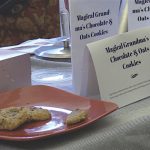When Iris Levin was a senior at Bowdoin 10 years ago, she wrote an honors thesis based on research she did with Bowdoin biology professor Nat Wheelwright and fellow student Meredith Swett ’99. Some of her thesis was published in Animal Behaviour, an academic journal of behavioral ecology, and still later the work was featured in the textbook, Essential Ornithology.
Since graduating, Levin has earned a Ph.D. in ecology, evolution and systematics from the University of Missouri-St. Louis. At present, she is a National Science Foundation postdoctoral fellow at the University of Colorado in Boulder. Recently she returned to Bowdoin to give a talk for one of the biology department’s weekly seminars.
Levin’s research focuses on interactions. “Life doesn’t occur in isolation,” she said. “Instead, we see amazing things when cells interact, or tissues interact, or organisms interact with each other or their environment.” She explained that some interactions are mutually beneficial, others parasitic and damaging. Many are not fully understood, she added.
Levin’s work examines not just one-on-one relationships, but also the impacts of many small-scale interactions on larger populations of animals. “Networks help us understand complex interactions,” she said.
For her dissertation research with biologist Patty Parker, Levin went to the Galapagos to study parasite transmission in seabirds. There she camped on islands and lived on boats and examined populations of parasites and the populations of birds they lived on. “We can use parasites to expand our knowledge of hosts,” she said.
In one study, she looked at a hierarchy of organisms: frigatebirds, blood-sucking flies that feed on the birds, and a malaria parasite that cycles between the bird and the fly. She was looking for what prompts flies, and therefore the malaria parasite, to switch hosts. Her findings determined that if a fly was carrying the parasite, it was less likely to switch bird hosts.
“This seems counterintuitive,” Levin said, “as the fly is the only means of transport for the malaria parasite.” She discussed the possibility that the parasite might need to be at a certain concentration to successfully infect another bird. “Even though few infected flies are moving, that’s enough for transmission,” she added.
An infectious disease biologist later published a commentary on Levin’s discovery, suggesting her work could be a public-health tool for better understanding the transmission of malaria in humans.
Levin’s current research with biologist Rebecca Safran involves barn swallows. For this project, she is looking into whether a bird’s phenotype, or what it looks like, affects its social position. “It’s like a popularity question for birds,” she joked. And she is also asking whether a bird’s social position affects its physiology, particularly its reaction to stress.
After measuring interactions between swallows by outfitting them with radio transceiver “backpacks,” Levin was able to tell which birds were interacting with one another. She could also measure how often they interacted, how close they were during these encounters, and how long their interactions lasted (e.g., if they perched together for half an hour on a telephone wire or flew by each for a few seconds).
After analyzing her data, Levin discovered that a barn swallow’s appearance does appear to influence its position in the social network. “Birds with darker plumage end up as more central birds,” she said. The darker a male’s ventral plumage feathers are, the more interactions it has with other males — presumably competitive confrontations. These dark males also had more encounters with females, most likely connected to mating.
Yet, there might be a downside to being popular, because the dark males also tested for higher stress levels. Levin’s future research will examine whether there are costs associated with social stress in the swallows.


